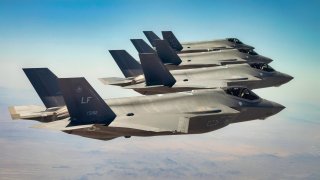NATO Is Slowly Becoming the F-35 Fighter Alliance
The Royal Netherlands Air Force has removed its fleet of F-16 Fighting Falcons from the BENELUX Air Policing duties and instead, the role will now be filled by the fifth-generation F-35 Lightning II to protect the airspace over Belgium, Luxembourg, and the Netherlands.
The Royal Netherlands Air Force has removed its fleet of F-16 Fighting Falcons from the BENELUX Air Policing duties and instead, the role will now be filled by the fifth-generation F-35 Lightning II to protect the airspace over Belgium, Luxembourg, and the Netherlands. The F-35 will now serve as the RNAF's Quick Reaction Alert (QRA) aircraft.
QRA is the state of readiness and modus operandi of air defense maintained at all hours of the day by NATO air forces, while the United States usually refers to Quick Reaction Alert as "Airspace Control Alert."
Change of Planes – Same Mission for F-35
The Netherlands' venerable F-16 had been permanently ready for QRA duties since 1981, and the Fighting Falcons were integrated into NATO's Air Policing arrangement controlled by the Combined Air Operations Centre at Uedem, Germany. That era came to an end on March 29, 2024, with the responsibility for the surveillance of the airspace of the three BENELUX nations transferred to two Dutch F-35s – at least for another month.
The Netherlands and Belgium alternate responsibility for the QRA every few months, and Belgium will take over again on May 9, 2024. According to NATO, two fighter aircraft are permanently available for QRA missions.
In the Netherlands, the Air Operations Control Station in Nieuw Milligen has control over the QRA; while in Belgium, QRA aircraft are deployed under the responsibility of the Control and Reporting Center (CRC) in Beauvechain.
Air combat control within Europe works closely together when unidentified aircraft fly into the airspace of a neighboring country. Should an aircraft pilot have no radio contact with Civilian Air Traffic Control, NATO Air Policing arrangements kick in and the QRA is alerted to intercept that aircraft.
This makes it possible to respond to a possible threat in a timely manner.
Truly Ready For Quick Response
Due to the short warning time, the aircraft are at the ready and can take off within minutes and intercept any unidentified aircraft. For the next month, the pair of Dutch F-35s will ensure safety and integrity over the three nations. Changes for the pilots will be minimal as the 24/7 enduring mission is performed by F-35s, which are stationed at the air bases at Leeuwarden and Volkel.
"The conditions remain the same," explained Major Nick, the squadron's deputy chief of operations. "The F-35 is above all a more modern platform, which makes things easier. The aircraft can fly longer and has better sensors - and it sends the right signal."
Multiple NATO allies are now integrating their F-35 into the international military alliance's standing Air Policing missions. During operational deployments under NATO enhanced Air Policing, the Royal Netherlands Air Force has flown their F-35s in Poland in 2023 and Bulgaria in 2022.
Author Experience and Expertise: Peter Suciu
Peter Suciu is a Michigan-based writer. He has contributed to more than four dozen magazines, newspapers, and websites with over 3,200 published pieces over a twenty-year career in journalism. He regularly writes about military hardware, firearms history, cybersecurity, politics, and international affairs. Peter is also a Contributing Writer for Forbes and Clearance Jobs. You can follow him on Twitter: @PeterSuciu. You can email the author: [email protected].
Image Credit: Lockheed Martin.


